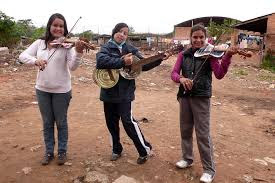Photo © The Nature Conservancy (Justine E. Hausheer)
Nature Conservancy scientists are using bioacoustic analyses to discover how different types of land uses affect biodiversity in the forests of Borneo.
Between 2000 and 2010, Indonesia lost 14.7 million hectares of forest. The four main drivers of deforestation in Indonesia are timber, oil palm, mining, and the pulp paper industry, all of which accounted for 44.7% of forest loss in Indonesia’s five main districts during that ten year period. (The rest was lost due to rubber plantations, small-scale agriculture, and village development)
With many logging areas transitioning to more intensive land uses, conservationists are looking to improve land-use planning to balance biodiversity conservation and resource production.
The Question: Is it better to use one portion of the land intensively and protect the rest (sparing), or is it better to lightly use a vast majority of the land, spreading out the less-intensive resource use (sharing)?
Answering this simple question is not so simple. Land use strategies by indusrty are already in place, and the effect of each strategy could vary depending upon the exact combination of land uses, how they are implemented, and how they are organized spatially across the whole landscape.
And that’s where acoustic data comes in.
The forest is never silent. With hundreds of species vocalizing simultaneously, the noise can be overwhelming to animal inhabitants. So different species evolved to communicate at different frequencies, or acoustic niches, so that individuals of one species can hear each other over the roar of all the other forest sounds.
Mist over East Kalimantan, Indonesia. Photo © The Nature Conservancy (Nick Hall)
Because each species has its own specific frequency, scientists can use acoustic data to calculate biodiversity — and therefore ecosystem health — by recording the forest soundscape over 24 hours. And those soundscapes are they key to understanding changes caused by development and resource extraction.
As with many ecological studies, complications abound. Measures of soundscape overall saturation, species similarity, species composition, disparate measures in different parts of the forest, and the problem of invasive species all muddy the water, so to speak. Nobody in the scientific community really knows what happens at a large scale, so this is brand new territory. Eventually, the team will conduct an analysis using species-recognition algorithms to compile a list of all audible species at each site, allowing them to cross-check the soundscape measures of diversity.
The bioacoustics research is part of a larger effort — funded by the Science for Nature and People Partnership (SNAPP) — to investigate how to best achieve conservation and benefits for people in tropical timber production landscapes.
In essence, the hope is to identify the deforestation "sweet spot." How to extract the maximum amount of resources while incurring the least amount of ecosystem damage.
Because if a tree falls in the forest, you bet it makes a sound.
To learn more about this project:
http://snappartnership.net/
https://blog.nature.org/science/2017/04/25/where-logging-reigns-going-beyond-sharing-vs-sparing/
http://research.ecosounds.org/
https://blog.nature.org/science/explainer/how-can-bioacoustics-help-conserve-biodiversity/?utm_source=cgs&utm_medium=archive&utm_campaign=explainer
https://blog.nature.org/science/2015/09/14/bioacoustics-for-conservation-land-use-planning/









